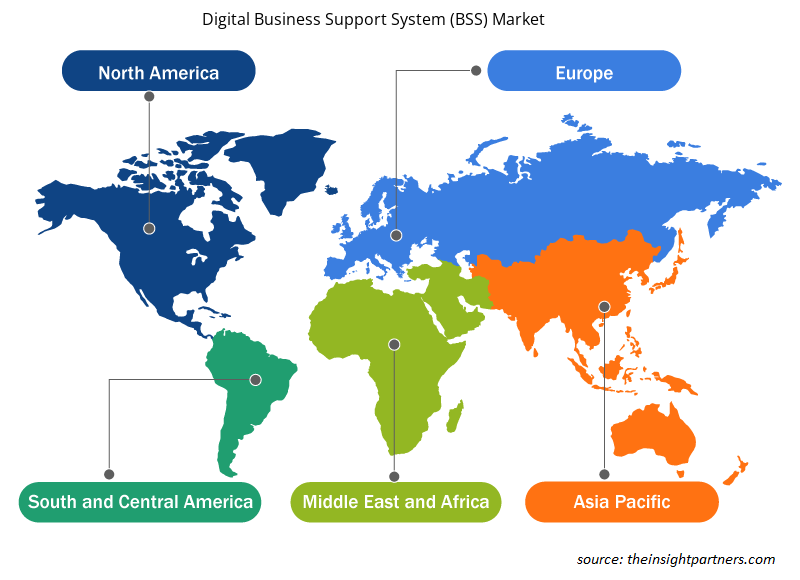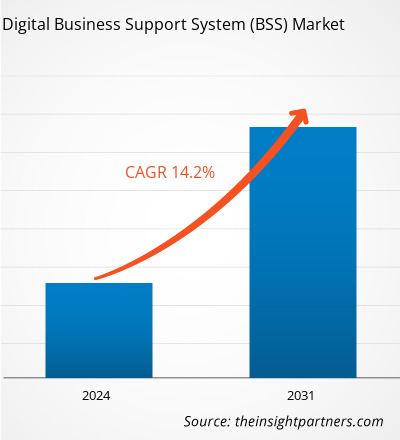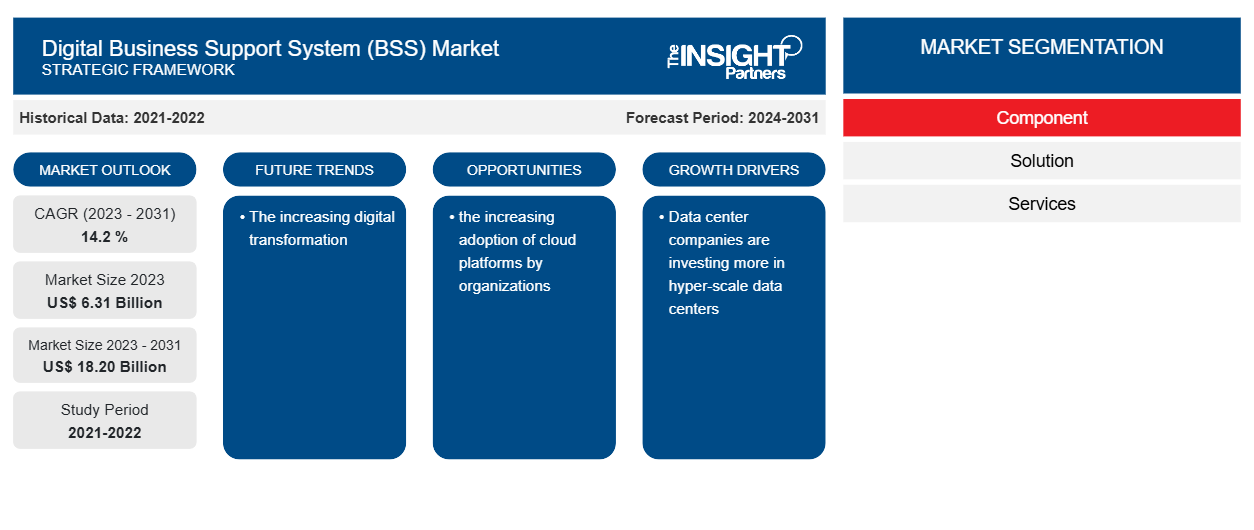Das Marktvolumen für digitale Business-Support-Systeme (BSS) soll von 6,31 Milliarden US-Dollar im Jahr 2023 auf 18,20 Milliarden US-Dollar im Jahr 2031 anwachsen. Für den Markt wird für den Zeitraum 2023–2031 eine durchschnittliche jährliche Wachstumsrate (CAGR) von 14,2 % erwartet.DerDie zunehmende digitale Transformation dürfte ein wichtiger Markttrend für digitale Business-Support-Systeme (BSS) bleiben.
Marktanalyse für digitale Business-Support-Systeme (BSS)
Der Markt für digitale Business-Support-Systeme wächst aufgrund einer Reihe von Faktoren rasant. Dazu gehören die zunehmende Einführung maßgeschneiderter BSS-Lösungen und neuer Geschäftsmodelle, die Steigerung der Betriebskosten, die Zunahme von Online-Transaktionen und die Verwendung mehrerer mobiler Geräte, die zunehmende Nutzung Cloud-basierter BSS-Lösungen, der steigende Digitalisierungstrend in der Telekommunikationsbranche und die zunehmende Einführung digitaler Business-Support-Systeme durch Hersteller, um dem Unternehmen einen Mehrwert zu bieten, indem der Return on Investment maximiert wird, indem besserer Kundenservice geboten, Kosten gesenkt und die Markteinführungszeit für neue Produkte und Dienstleistungen verkürzt wird.
Marktübersicht für digitale Business-Support-Systeme (BSS)
Ein digitales Business-Support-System ist eine Art Plattform oder Lösung, die kommerziellen Unternehmen betriebliche Vorteile und Überwachung bietet. Auftragsannahme, zahlungsbezogene Anfragen und Kundeneinkommensverwaltung sind alle Teil des Business-Support-Systems. Neben zahlreichen zusätzlichen Betriebsmanagement-Tools bietet das System Unternehmen Einblicke in Marketing und Unternehmensbetrieb, die es ihnen ermöglichen, fundierte Entscheidungen über Produkteinführungen und Marketingausgaben zu treffen .
Passen Sie diesen Bericht Ihren Anforderungen an
Sie erhalten kostenlose Anpassungen an jedem Bericht, einschließlich Teilen dieses Berichts oder einer Analyse auf Länderebene, eines Excel-Datenpakets sowie tolle Angebote und Rabatte für Start-ups und Universitäten.
-
Holen Sie sich die wichtigsten Markttrends aus diesem Bericht.Dieses KOSTENLOSE Beispiel umfasst eine Datenanalyse von Markttrends bis hin zu Schätzungen und Prognosen.
Markttreiber und Chancen für digitale Business-Support-Systeme (BSS)
Rechenzentrumsunternehmen investieren mehr in Hyperscale-Rechenzentren.
Zahlreiche Rechenzentrumsunternehmen haben erhebliche Investitionen in Hyperscale-Rechenzentren getätigt, von denen man sich lukrative Expansionsaussichten verspricht. Equinix gab im vergangenen Jahr bekannt, dass es in einigen bedeutenden europäischen Märkten rund 32 Hyperscale-Rechenzentren bauen will. Mit einer Investition von über 6,9 Milliarden USD und einer Gesamtkapazität von über 600 Megawatt hofft das Unternehmen, seine Position auf dem sich rasch entwickelnden Markt für Hyperscale-Rechenzentren zu verbessern. Die Nachfrage nach dem HCI-Markt in der Region wird durch diese Expansion der Rechenzentren in der Region steigen.Equinix revealed intentions to build about 32 hyper-scale data centers in a few significant European markets last year. Investing more than USD 6.9 billion and having a total capacity of over 600 megawatts, the company hopes to improve its standing in the rapidly developing hyper-scale data center market. The demand for the HCI market in the region will rise as a result of this expansion of the data centers in the area.
Die zunehmende Nutzung von Cloud-Plattformen durch Organisationen
Die zunehmende Nutzung von Cloud-Plattformen durch Organisationen, insbesondere in Schwellenländern, wird voraussichtlich das Wachstum des Marktes für digitale Business-Support-Systeme im asiatisch-pazifischen Raum vorantreiben. Laut dem Nutanix Cloud Index wird sich beispielsweise die Nutzung hybrider Cloud-Workloads in Indien voraussichtlich von 13 Prozent auf 43 Prozent verdreifachen. Das Unternehmen konzentriert sich aufgrund der zunehmenden Nutzung digitaler Technologien zur Kundenbindung stärker auf die Geschäftserweiterung und die Entwicklung neuer Produkte. Daher wird erwartet, dass der zunehmende Bedarf an Datengenauigkeit und Datenmanagement den Akteuren auf dem Markt für digitale Business-Support-Systeme (BSS) im Prognosezeitraum neue Möglichkeiten bietet.Nutanix Cloud Index. The corporation is focusing more on business expansion and new product development as a result of the increased use of digital technologies for consumer engagement. Thus, the increasing need for data accuracy and data management is anticipated to present new opportunities for the Digital Business Support System (BSS) Market players during the forecast period.
Marktbericht zum digitalen Business-Support-System (BSS) – SegmentierungsanalyseBSS) Market Report Segmentation Analysis
Wichtige Segmente, die zur Ableitung der Marktanalyse für digitale Business-Support-Systeme (BSS) beigetragen haben, sind Komponenten.BSS) Market analysis are components.
- Basierend auf der Komponente ist der Markt für digitale Business-Support-Systeme (BSS) in Lösungen und Dienste unterteilt. Das Dienstleistungssegment hatte im Jahr 2023 einen größeren Marktanteil.BSS) Market is segmented into solutions and services. The services segment held a larger market share in 2023.
Digital Business Support System (BSS) Marktanteilsanalyse nach GeografieBSS) Market Share Analysis by Geography
Der geografische Umfang des Marktberichts für digitale Business-Support-Systeme (BSS) ist hauptsächlich in fünf Regionen unterteilt: Nordamerika, Asien-Pazifik, Europa, Naher Osten und Afrika sowie Südamerika/Süd- und Mittelamerika. In Bezug auf den Umsatz hatte Nordamerika den größten Marktanteil für digitale Business-Support-Systeme (BSS). Im Vergleich zu anderen Regionen erlebt Nordamerika ein schnelleres Wachstum der Startup-Kultur. Die Entstehung von KMU und die zunehmende Digitalisierung der Telekommunikationsbranche haben zur Expansion des digitalen BSS-Marktes in Nordamerika beigetragen. Die zunehmende Verfügbarkeit von Cloud-basierten Lösungen ist ein weiterer Faktor, der die Einführung digitaler BSS-Lösungen in der Region vorantreibt. Im Vergleich zu herkömmlichen Lösungen vor Ort bieten Cloud-basierte BSS-Lösungen eine Reihe von Vorteilen, wie z. B. geringere Vorlaufkosten, höhere Sicherheit und flexible Skalierbarkeit. Diese Elemente werden wahrscheinlich dazu beitragen, dass die Einführung digitaler BSS-Lösungen in Nordamerika in den kommenden Jahren weiter zunimmt.
Regionale Einblicke in den Markt für digitale Business-Support-Systeme (BSS)
Die regionalen Trends und Faktoren, die den Markt für digitale Business-Support-Systeme (BSS) während des Prognosezeitraums beeinflussen, wurden von den Analysten von Insight Partners ausführlich erläutert. In diesem Abschnitt werden auch die Marktsegmente und die Geografie von digitalen Business-Support-Systemen (BSS) in Nordamerika, Europa, im asiatisch-pazifischen Raum, im Nahen Osten und Afrika sowie in Süd- und Mittelamerika erörtert.

- Erhalten Sie regionale Daten zum Markt für digitale Business-Support-Systeme (BSS).
Umfang des Marktberichts zum digitalen Business-Support-System (BSS)
| Berichtsattribut | Details |
|---|---|
| Marktgröße im Jahr 2023 | 6,31 Milliarden US-Dollar |
| Marktgröße bis 2031 | 18,20 Milliarden US-Dollar |
| Globale CAGR (2023 - 2031) | 14,2 % |
| Historische Daten | 2021-2022 |
| Prognosezeitraum | 2024–2031 |
| Abgedeckte Segmente |
Nach Komponente
|
| Abgedeckte Regionen und Länder |
Nordamerika
|
| Marktführer und wichtige Unternehmensprofile |
|
Marktteilnehmerdichte für digitale Business-Support-Systeme (BSS): Auswirkungen auf die Geschäftsdynamik verstehen
Der Markt für digitale Business-Support-Systeme (BSS) wächst rasant. Dies wird durch die steigende Nachfrage der Endnutzer aufgrund von Faktoren wie sich entwickelnden Verbraucherpräferenzen, technologischen Fortschritten und einem größeren Bewusstsein für die Vorteile des Produkts vorangetrieben. Mit der steigenden Nachfrage erweitern Unternehmen ihr Angebot, entwickeln Innovationen, um die Bedürfnisse der Verbraucher zu erfüllen, und nutzen neue Trends, was das Marktwachstum weiter ankurbelt.
Die Marktteilnehmerdichte bezieht sich auf die Verteilung der Firmen oder Unternehmen, die in einem bestimmten Markt oder einer bestimmten Branche tätig sind. Sie gibt an, wie viele Wettbewerber (Marktteilnehmer) in einem bestimmten Marktraum im Verhältnis zu seiner Größe oder seinem gesamten Marktwert präsent sind.
Die wichtigsten Unternehmen auf dem Markt für digitale Business-Support-Systeme (BSS) sind:
- Amdocs Limited
- Huawei Technologies Co., Ltd.
- Telefonaktiebolaget LM Ericsson
- NetCracker Technology Corporation
- CSG Systems International, Inc.
- Optiva Inc.
Haftungsausschluss : Die oben aufgeführten Unternehmen sind nicht in einer bestimmten Reihenfolge aufgeführt.

- Überblick über die wichtigsten Akteure auf dem Markt für digitale Business-Support-Systeme (BSS)
Marktnachrichten und aktuelle Entwicklungen zum Digital Business Support System (BSS)
Der Markt für digitale Business-Support-Systeme (BSS) wird durch die Erhebung qualitativer und quantitativer Daten nach Primär- und Sekundärforschung bewertet, die wichtige Unternehmensveröffentlichungen, Verbandsdaten und Datenbanken umfasst. Im Folgenden finden Sie eine Liste der Entwicklungen auf dem Markt für Sprach- und Sprechstörungen und -strategien:
- Im Juni 2023 unterzeichneten IBM und Vista Equity Partners einen endgültigen Vertrag zur Übernahme von Apptio Inc. durch IBM. Die IT-Automatisierungskapazitäten von IBM werden durch die Übernahme von Apptio schneller wachsen, was Unternehmensleitern die Möglichkeit gibt, den Ertrag ihrer IT-Investitionen zu maximieren.
(Quelle: IBM, Pressemitteilung)
- Im Juli 2022 kaufte Ericsson Vonage und treibt damit den Plan des Unternehmens voran, seine Position als Technologieführer zu nutzen, um sein Mobilfunkgeschäft anzukurbeln und in den Unternehmensbereich vorzudringen.
(Quelle: Ericsson, Pressemitteilung)
Marktbericht zum digitalen Business-Support-System (BSS): Abdeckung und Ergebnisse
Der Bericht „Marktgröße und Prognose für digitale Business-Support-Systeme (BSS) (2021–2031)“ bietet eine detaillierte Analyse des Marktes, die die folgenden Bereiche abdeckt:
- Marktgröße und Prognose auf globaler, regionaler und Länderebene für alle wichtigen Marktsegmente, die im Rahmen des Projekts abgedeckt sind
- Marktdynamik wie Treiber, Beschränkungen und wichtige Chancen
- Wichtige Zukunftstrends
- Detaillierte PEST/Porters Five Forces- und SWOT-Analyse
- Globale und regionale Marktanalyse mit wichtigen Markttrends, wichtigen Akteuren, Vorschriften und aktuellen Marktentwicklungen
- Branchenlandschaft und Wettbewerbsanalyse, einschließlich Marktkonzentration, Heatmap-Analyse, prominenten Akteuren und aktuellen Entwicklungen
- Detaillierte Firmenprofile
- Historische Analyse (2 Jahre), Basisjahr, Prognose (7 Jahre) mit CAGR
- PEST- und SWOT-Analyse
- Marktgröße Wert/Volumen – Global, Regional, Land
- Branchen- und Wettbewerbslandschaft
- Excel-Datensatz
Aktuelle Berichte
Erfahrungsberichte
Grund zum Kauf
- Fundierte Entscheidungsfindung
- Marktdynamik verstehen
- Wettbewerbsanalyse
- Kundeneinblicke
- Marktprognosen
- Risikominimierung
- Strategische Planung
- Investitionsbegründung
- Identifizierung neuer Märkte
- Verbesserung von Marketingstrategien
- Steigerung der Betriebseffizienz
- Anpassung an regulatorische Trends























 Kostenlose Probe anfordern für - Markt für digitale Business-Support-Systeme (BSS)
Kostenlose Probe anfordern für - Markt für digitale Business-Support-Systeme (BSS)